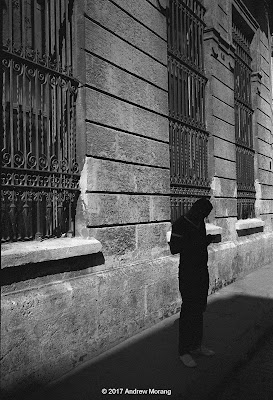As I wrote earlier, Havana is a glorious display of faded architectural extravagance. Six decades of no maintenance in a humid climate, and almost every house has filth, spalling concrete, imploding floors, dripping pipes, and dingy balconies with hanging laundry. Toilets are as bad as Istanbul (but not as revolting as Sofia in 1978). All is superimposed on what was once extravagant art deco, art nouveau, postwar modernist, and Spanish colonial architecture with Grecian elements. Havana is amazing because this nostalgic luxury coincides with extreme poverty. People live in these grand faded townhouses, putting up with dingy stairwells, peeling paint, and crumbling facades and balconies.
The following pictures are from semi-random walks around Centro. Please read the captions for the locations and click any picture to enlarge to 1600 pixels wide.
 |
| Cuban caryatids at 206 Virtudes ("a sculpted female figure serving as an architectural support taking the place of a column or a pillar supporting an entablature on her head") |
 |
| The corner of Havana and Blanco Streets. |
 |
| 325 Animas and its cheerful inhabitants. Note the exposed steel beams under the balcony - might they be corroded? |
 |
| 452 Animas. The street, like everything else, needed a bit of repair. |
 |
| Hanging around at 156 Campanario. |
 |
| Hanging around at 162 Campanario. |
 |
| Havana and Virtudes. It looks like the corner building once had big windows, but possibly the facade is still original. |
 |
| The domino champions, 114 Lealtad. Note how they are supporting their plywood table on their knees. |
 |
| Finally, a vegetable/grocery store at 519 Empedrado. We were surprised how few food stores served these neighborhoods, at least where we explored. The produce did not look too appetizing. |
 |
| Well, Che is here in the grocery store to remind you that the revolution is all-important. 519 Empedrado. |
 |
| Another rather unappealing (revolting) vegetable stand at 313 San Miguel. |
 |
| An occasional empty lot means whatever structure was once on the site collapsed and the debris was taken away. 265 San Miguel. |
 |
| A common sight: a bunch of guys fixing a car. 216 Campanario. |
I took these photographs taken with a Leica M2 35mm rangefinder camera with (mostly) the 35mm ƒ/2.0 Summicron lens. Film: Kodak Tri-X 400 film, exposed at ISO 320 and developed in Kodak HC-110 developer.
Older Havana articles:
https://worldofdecay.blogspot.com/2017/02/our-man-in-havana-4-habana-viejo-in-film.html
https://worldofdecay.blogspot.com/2017/02/our-man-in-havana-3-view-from-top.html
https://worldofdecay.blogspot.com/2017/02/our-man-in-havana-2-on-waterfront.html
https://worldofdecay.blogspot.com/2017/02/our-man-in-havana-1-hershey-train.html







































